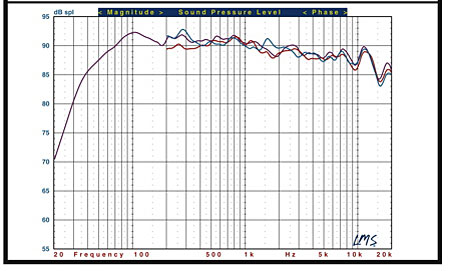Pioneer EX Series Surround Speaker System Measurements
All measurements were taken with the grilles removed.
The impedance of the S-1EX is typical of a ported loudspeaker tuned to approximately 34Hz, with a minimum impedance of 5.8Ω at 100Hz. The phase angle of the load is relatively benign. I would rate the speaker's nominal impedance at 8Ω. The speaker's sensitivity is approximately 90dB/2.83V/m. It should be an easy load for any competent amplifier.
The horizontal front response of the S-1EX is shown in Fig.1 (violet). This is the pseudo-anechoic response averaged over a 30° forward horizontal angle, taken at tweeter height, combined with the nearfield responses of the woofers and port.

Fig.1: Pioneer S-1EX, pseudo-anechoic response at 45° (red) and 60° (blue) off-axis in the horizontal plane.
This ±15° averaged front horizontal response is very smooth. The horizontal off-axis response tracks the on-axis result fairly closely, though it does have a much more rapid rolloff as frequency increases. The effective lower limit of the bass is about 32Hz (-10dB).
Fig.2 shows the same averaged horizontal front response (purple), this time overlaid with the vertical responses taken at +15° (red) and –15° (blue). These curves suggest that the vertical position of your ear with respect to the elevation of the tweeter will not, within reason, be critical with this speaker.

Fig.2: Pioneer S-1EX, pseudo-anechoic response at 15° above (red) and 15° below (blue) the tweeter axis.
The Pioneer S-7EX center speaker's sealed cabinet is tuned to about 40Hz. Its minimum impedance measured 4.5Ω at 134Hz. I would rate its nominal impedance, very conservatively, at 7Ω, and its phase angle should not be a problem. Its sensitivity measured approximately 89dB/2.83V/m. As with the S-1EX, it should be an easy load to drive, though the minimum impedance here is lower. But as long as your amp or receiver is tolerant of a 4Ω load you are unlikely to experience a problem.
The measured front horizontal response of the S-7EX, taken on the tweeter axis and averaged in the same manner as described above for the S-1EX, is shown in Fig.3 (violet curve). The useful bass limit is approximately 41Hz (-10dB). The on-axis response is very smooth and flat, though with a slightly deeper plateau from 2kHz-10kHz than with the S-1EX. The off-axis response isn't as smooth, either, but because of the concentric midrange-tweeter driver it does not have the severe off-axis suckouts present in many horizontally configured speakers.

Fig.3: Pioneer S-7EX, pseudo-anechoic response at 45° (red) and 60° (blue) off-axis in the horizontal plane.
Fig.4 shows the vertical response of the S-7EX at + 15° (red) and –15° (blue), overlaid again with the averaged front horizontal response. As with the S-1EX, the vertical ear height is relatively non-critical.

Fig.4: Pioneer S-7EX, pseudo-anechoic response at 15° above (red) and 15° below (blue) the tweeter axis.
Comment: The slightly warm and rich sound I heard from the Pioneer speakers is not immediately evident in their unusually smooth and linear measurements. Look closely however, and you will see that the S-1EX's averaged front response slopes down slightly. This is more pronounced in the off-axis performance and a bit more evident in the S-7EX as well. But it is a subtle thing. The S-1EX, in particular, has some of the smoothest response curves we have ever measured. Their slight downward slope may indicate a speaker that might sound a little soft (but not dull) in some rooms, but also one that is unlikely to either hide or exaggerate problems in the program material. This is exactly what I heard.
All figures: Violet curve: pseudo-anechoic response on the front axis, averaged across a 30° horizontal window, combined with nearfield responses of the woofers and port. All measurements were taken at one meter.
- Log in or register to post comments




































































